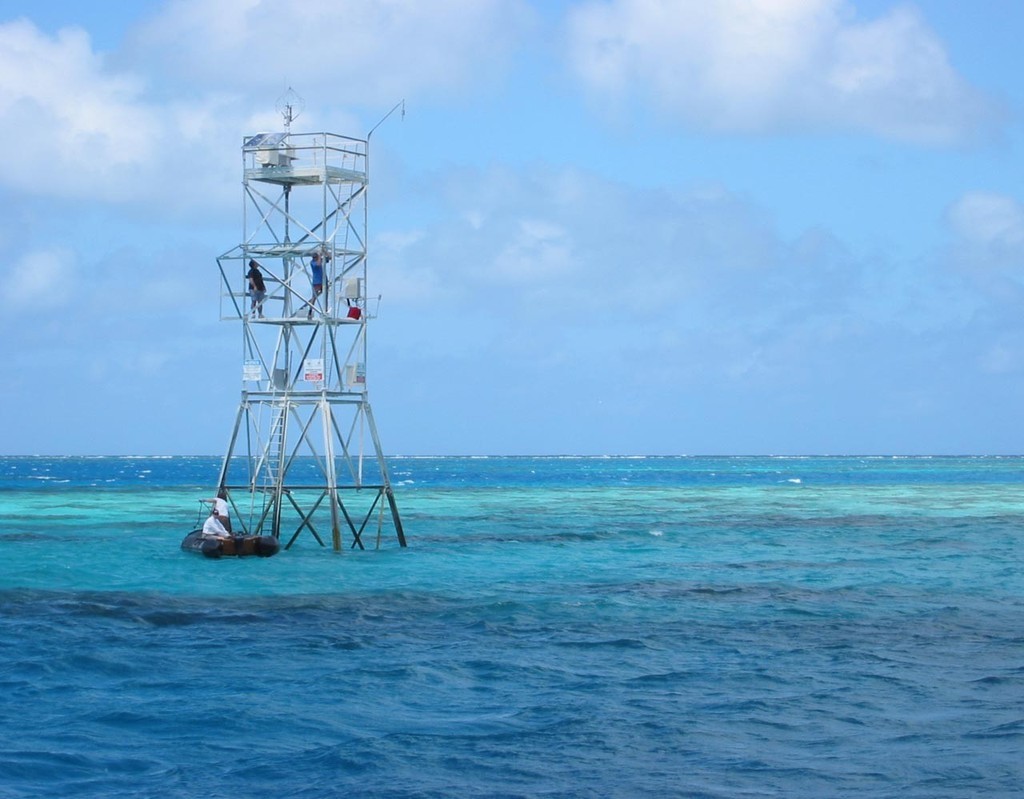Support builds for a Great Barrier Reef automated reef watch
by ARC Centre of Excellence Coral Reef Studies on 8 Apr 2009

Davies Reef weather station powered by solar panels collects the continuous stream of readings from the reef and sends them back to AIMS ARC Centre of Excellence Coral Reef Studies
http://www.coralcoe.org.au/
There is strong support for developing the next generation of a high-tech sensor network to watch over the health and resilience of the vast area of Australia’s Great Barrier Reef, a new study has found.
Reef managers and coral scientists are strongly in favour of developing an automated intelligent system for monitoring key aspects of water quality and factors affecting the health of the GBR, says Debora de Freitas of the ARC Centre of Excellence in Coral Reef Studies (CoECRS) and James Cook University.
The proposed sensor network is intended to keep watch over the Great Barrier Reef (GBR), the world’s largest protected marine park, consisting of thousands of individual reefs scattered from Bundaberg to the Torres Strait over 2000km and would build on the existing Great Barrier Reef Ocean Observing System (GBROOS) project by looking at inshore remote stations and by rolling out the next generation of high-tech sensors and systems.
It is envisaged as an ‘intelligent’ network of sensors and transmitters gathering, sharing, analysing and sending reports on water conditions at hundreds of points along the GBR 24 hours a day. These will monitor things such as water temperature, light at depth, wave conditions, currents, water chemistry and water clarity in real time. It is intended to form part of the enhanced GBROOS system funded by the Queensland State and Federal Governments under the Integrated Marine Observing System (IMOS) project.
An initial sensor network has been successfully tested at a number of sites along the GBR by the Australian Institute of Marine Science (AIMS) and further deployments are planned this year. Ms de Freitas’ work is helping to determine how the information will be used.
'Like many other ecological systems, the GBR is threatened by the impact of humans and climate change. Prolonged exposure to high water temperatures resulting from global warming can kill corals while run-off of silt and chemicals from the land may also have a detrimental effect,' Debora explains.
'Although it is a challenge to collate and deliver the right data at the appropriate spatial and temporal scales in a cost- and time effective manner, the use of real-time data from reef-based sensor arrays has great potential in policy and management decision making. An additional complication is that the GBR is a large complex system situated in a remote location and the impacts of these effects are often impossible to accurately predict. A need therefore exists to adequately monitor conditions all over the Great Barrier Reef so as to predict future trends and give early warning of possible threats. Coral reef and coastal managers want to know the status of the reef through new technologies and the deployment of the sensor networks at the GBR will greatly support that'.
There is also strong evidence that the various sections of the GBR interact with each other and that the health of the GBR overall will depend on monitoring conditions over different parts of the whole reef system, she adds.
'We found there was strong support both from scientists and reef managers for a sensor network to be established on the Reef to give them instant feedback on conditions at hundreds of points across a vast area.
'Reef managers, for example, want to know what is going on in real time and over a much wider area, so they can make more timely decisions than are possible with the present data, which is gathered from satellites and data loggers.
'Scientists want to understand what is actually going on in the processes of the reef, when there is no-one there to observe them – for example during a cyclone, or as a result of climate change and coral bleaching events. From a sensor network they can obtain real information about the large-scale processes which affect the health of the reef.
The sensors can be set up to report every few hours – or several times a second, depending on the need. The network can ‘learn’ what is required of it, Debora says. It will need considerable data mining and analysis capability on land to extract useful information from the data collected by sensors spread all along the Reef.
The article 'Linking science and management in the adoption of sensor network technology in the Great Barrier Reef coast, Australia' was published in the latest issue of Computers, Environment and Urban Systems by Elsevier. Its authors are Debora de Freitas, Stuart Kininmonth (AIMS) and Simon Woodley.
[Sorry, this content could not be displayed]
http://www.coralcoe.org.au
If you want to link to this article then please use this URL: www.sail-world.com/55582